Business Law: Case Analysis of Contractual Obligations and Damages
VerifiedAdded on 2020/12/10
|10
|2295
|100
Report
AI Summary
This report analyzes a business law case concerning a Malaysian businessman, Mr. Huang, who contracted a builder for factory construction but faced delays, leading to a breach of contract. The analysis delves into the Contract Act of 1950, examining essential elements like offer, acceptance, consideration, and consent. The core issue revolves around whether the builder is liable for the tender Mr. Huang lost due to the delay. The report explores damages, particularly the impact of the delay on Mr. Huang's business, and considers the principles of remoteness of damage and foreseeability, referencing cases like Hadley v. Baxendale and Victoria Laundry (Windsor) Ltd. v. Newman Industries Ltd. It further examines the measure and mitigation of damages, concluding that Mr. Huang might not be entitled to the tender value due to lack of communication, and the court's role in compensating the aggrieved party. The report emphasizes the importance of clear communication and the legal implications of contractual obligations.

Business Law assignment 1
Paraphrase This Document
Need a fresh take? Get an instant paraphrase of this document with our AI Paraphraser
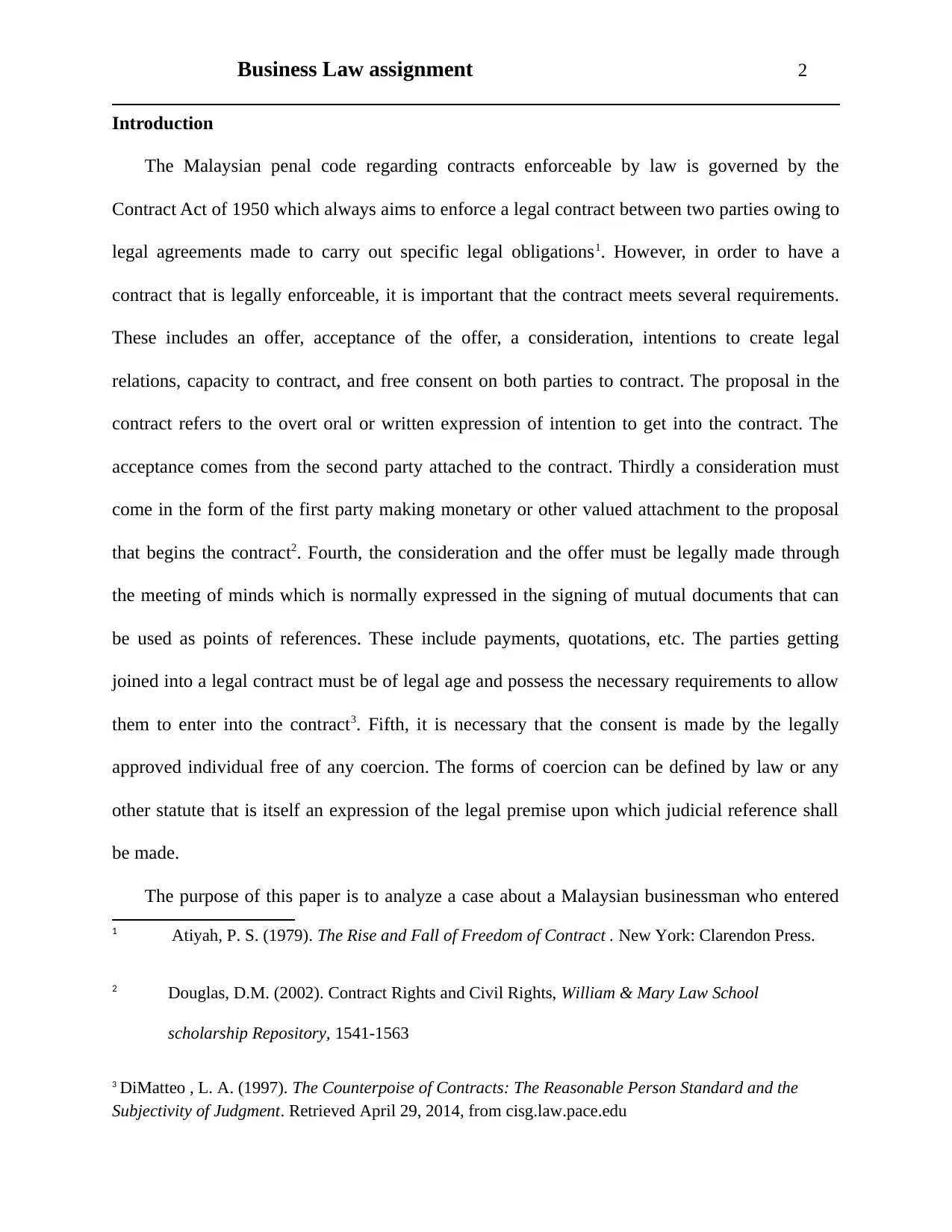
Business Law assignment 2
Introduction
The Malaysian penal code regarding contracts enforceable by law is governed by the
Contract Act of 1950 which always aims to enforce a legal contract between two parties owing to
legal agreements made to carry out specific legal obligations1. However, in order to have a
contract that is legally enforceable, it is important that the contract meets several requirements.
These includes an offer, acceptance of the offer, a consideration, intentions to create legal
relations, capacity to contract, and free consent on both parties to contract. The proposal in the
contract refers to the overt oral or written expression of intention to get into the contract. The
acceptance comes from the second party attached to the contract. Thirdly a consideration must
come in the form of the first party making monetary or other valued attachment to the proposal
that begins the contract2. Fourth, the consideration and the offer must be legally made through
the meeting of minds which is normally expressed in the signing of mutual documents that can
be used as points of references. These include payments, quotations, etc. The parties getting
joined into a legal contract must be of legal age and possess the necessary requirements to allow
them to enter into the contract3. Fifth, it is necessary that the consent is made by the legally
approved individual free of any coercion. The forms of coercion can be defined by law or any
other statute that is itself an expression of the legal premise upon which judicial reference shall
be made.
The purpose of this paper is to analyze a case about a Malaysian businessman who entered
1 Atiyah, P. S. (1979). The Rise and Fall of Freedom of Contract . New York: Clarendon Press.
2 Douglas, D.M. (2002). Contract Rights and Civil Rights, William & Mary Law School
scholarship Repository, 1541-1563
3 DiMatteo , L. A. (1997). The Counterpoise of Contracts: The Reasonable Person Standard and the
Subjectivity of Judgment. Retrieved April 29, 2014, from cisg.law.pace.edu
Introduction
The Malaysian penal code regarding contracts enforceable by law is governed by the
Contract Act of 1950 which always aims to enforce a legal contract between two parties owing to
legal agreements made to carry out specific legal obligations1. However, in order to have a
contract that is legally enforceable, it is important that the contract meets several requirements.
These includes an offer, acceptance of the offer, a consideration, intentions to create legal
relations, capacity to contract, and free consent on both parties to contract. The proposal in the
contract refers to the overt oral or written expression of intention to get into the contract. The
acceptance comes from the second party attached to the contract. Thirdly a consideration must
come in the form of the first party making monetary or other valued attachment to the proposal
that begins the contract2. Fourth, the consideration and the offer must be legally made through
the meeting of minds which is normally expressed in the signing of mutual documents that can
be used as points of references. These include payments, quotations, etc. The parties getting
joined into a legal contract must be of legal age and possess the necessary requirements to allow
them to enter into the contract3. Fifth, it is necessary that the consent is made by the legally
approved individual free of any coercion. The forms of coercion can be defined by law or any
other statute that is itself an expression of the legal premise upon which judicial reference shall
be made.
The purpose of this paper is to analyze a case about a Malaysian businessman who entered
1 Atiyah, P. S. (1979). The Rise and Fall of Freedom of Contract . New York: Clarendon Press.
2 Douglas, D.M. (2002). Contract Rights and Civil Rights, William & Mary Law School
scholarship Repository, 1541-1563
3 DiMatteo , L. A. (1997). The Counterpoise of Contracts: The Reasonable Person Standard and the
Subjectivity of Judgment. Retrieved April 29, 2014, from cisg.law.pace.edu
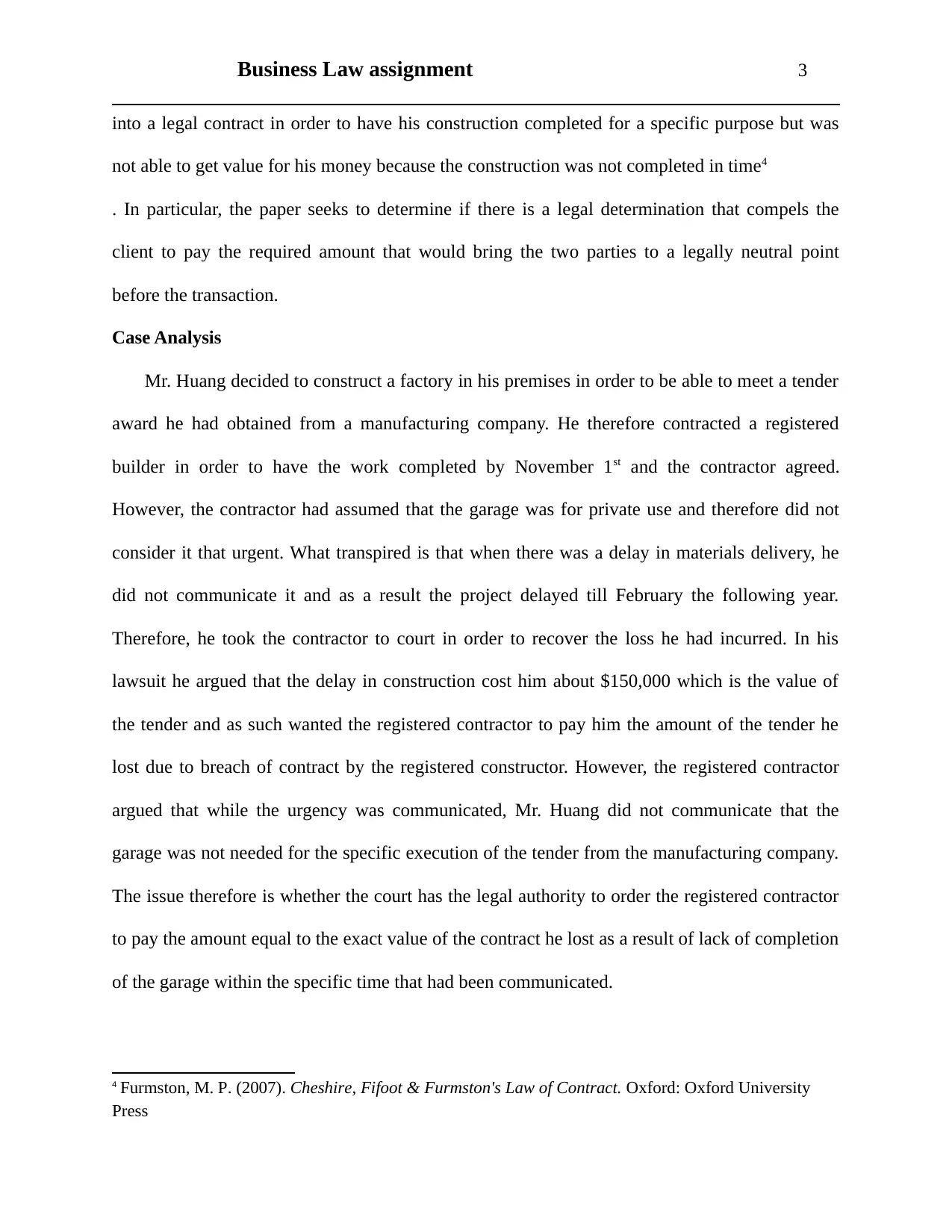
Business Law assignment 3
into a legal contract in order to have his construction completed for a specific purpose but was
not able to get value for his money because the construction was not completed in time4
. In particular, the paper seeks to determine if there is a legal determination that compels the
client to pay the required amount that would bring the two parties to a legally neutral point
before the transaction.
Case Analysis
Mr. Huang decided to construct a factory in his premises in order to be able to meet a tender
award he had obtained from a manufacturing company. He therefore contracted a registered
builder in order to have the work completed by November 1st and the contractor agreed.
However, the contractor had assumed that the garage was for private use and therefore did not
consider it that urgent. What transpired is that when there was a delay in materials delivery, he
did not communicate it and as a result the project delayed till February the following year.
Therefore, he took the contractor to court in order to recover the loss he had incurred. In his
lawsuit he argued that the delay in construction cost him about $150,000 which is the value of
the tender and as such wanted the registered contractor to pay him the amount of the tender he
lost due to breach of contract by the registered constructor. However, the registered contractor
argued that while the urgency was communicated, Mr. Huang did not communicate that the
garage was not needed for the specific execution of the tender from the manufacturing company.
The issue therefore is whether the court has the legal authority to order the registered contractor
to pay the amount equal to the exact value of the contract he lost as a result of lack of completion
of the garage within the specific time that had been communicated.
4 Furmston, M. P. (2007). Cheshire, Fifoot & Furmston's Law of Contract. Oxford: Oxford University
Press
into a legal contract in order to have his construction completed for a specific purpose but was
not able to get value for his money because the construction was not completed in time4
. In particular, the paper seeks to determine if there is a legal determination that compels the
client to pay the required amount that would bring the two parties to a legally neutral point
before the transaction.
Case Analysis
Mr. Huang decided to construct a factory in his premises in order to be able to meet a tender
award he had obtained from a manufacturing company. He therefore contracted a registered
builder in order to have the work completed by November 1st and the contractor agreed.
However, the contractor had assumed that the garage was for private use and therefore did not
consider it that urgent. What transpired is that when there was a delay in materials delivery, he
did not communicate it and as a result the project delayed till February the following year.
Therefore, he took the contractor to court in order to recover the loss he had incurred. In his
lawsuit he argued that the delay in construction cost him about $150,000 which is the value of
the tender and as such wanted the registered contractor to pay him the amount of the tender he
lost due to breach of contract by the registered constructor. However, the registered contractor
argued that while the urgency was communicated, Mr. Huang did not communicate that the
garage was not needed for the specific execution of the tender from the manufacturing company.
The issue therefore is whether the court has the legal authority to order the registered contractor
to pay the amount equal to the exact value of the contract he lost as a result of lack of completion
of the garage within the specific time that had been communicated.
4 Furmston, M. P. (2007). Cheshire, Fifoot & Furmston's Law of Contract. Oxford: Oxford University
Press
⊘ This is a preview!⊘
Do you want full access?
Subscribe today to unlock all pages.

Trusted by 1+ million students worldwide
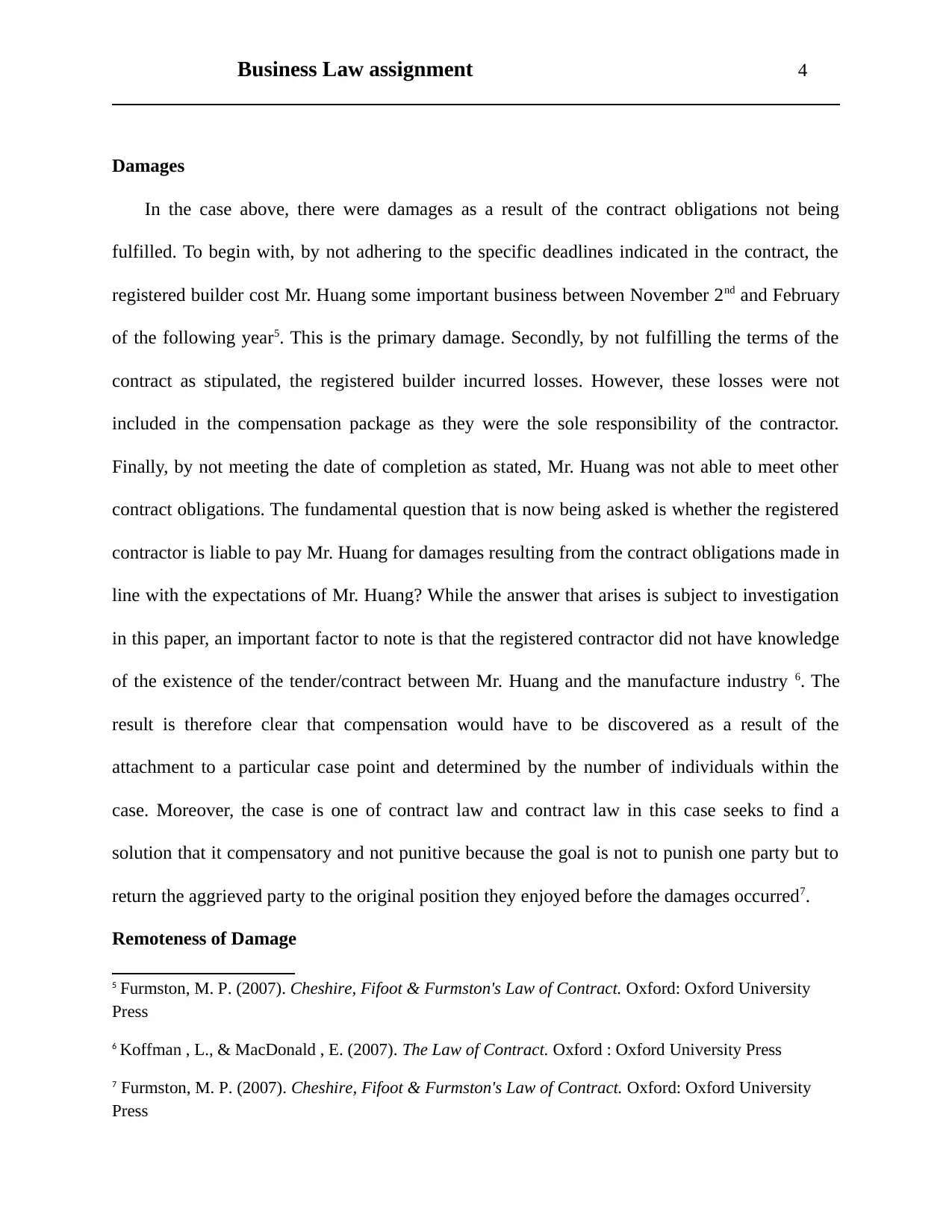
Business Law assignment 4
Damages
In the case above, there were damages as a result of the contract obligations not being
fulfilled. To begin with, by not adhering to the specific deadlines indicated in the contract, the
registered builder cost Mr. Huang some important business between November 2nd and February
of the following year5. This is the primary damage. Secondly, by not fulfilling the terms of the
contract as stipulated, the registered builder incurred losses. However, these losses were not
included in the compensation package as they were the sole responsibility of the contractor.
Finally, by not meeting the date of completion as stated, Mr. Huang was not able to meet other
contract obligations. The fundamental question that is now being asked is whether the registered
contractor is liable to pay Mr. Huang for damages resulting from the contract obligations made in
line with the expectations of Mr. Huang? While the answer that arises is subject to investigation
in this paper, an important factor to note is that the registered contractor did not have knowledge
of the existence of the tender/contract between Mr. Huang and the manufacture industry 6. The
result is therefore clear that compensation would have to be discovered as a result of the
attachment to a particular case point and determined by the number of individuals within the
case. Moreover, the case is one of contract law and contract law in this case seeks to find a
solution that it compensatory and not punitive because the goal is not to punish one party but to
return the aggrieved party to the original position they enjoyed before the damages occurred7.
Remoteness of Damage
5 Furmston, M. P. (2007). Cheshire, Fifoot & Furmston's Law of Contract. Oxford: Oxford University
Press
6 Koffman , L., & MacDonald , E. (2007). The Law of Contract. Oxford : Oxford University Press
7 Furmston, M. P. (2007). Cheshire, Fifoot & Furmston's Law of Contract. Oxford: Oxford University
Press
Damages
In the case above, there were damages as a result of the contract obligations not being
fulfilled. To begin with, by not adhering to the specific deadlines indicated in the contract, the
registered builder cost Mr. Huang some important business between November 2nd and February
of the following year5. This is the primary damage. Secondly, by not fulfilling the terms of the
contract as stipulated, the registered builder incurred losses. However, these losses were not
included in the compensation package as they were the sole responsibility of the contractor.
Finally, by not meeting the date of completion as stated, Mr. Huang was not able to meet other
contract obligations. The fundamental question that is now being asked is whether the registered
contractor is liable to pay Mr. Huang for damages resulting from the contract obligations made in
line with the expectations of Mr. Huang? While the answer that arises is subject to investigation
in this paper, an important factor to note is that the registered contractor did not have knowledge
of the existence of the tender/contract between Mr. Huang and the manufacture industry 6. The
result is therefore clear that compensation would have to be discovered as a result of the
attachment to a particular case point and determined by the number of individuals within the
case. Moreover, the case is one of contract law and contract law in this case seeks to find a
solution that it compensatory and not punitive because the goal is not to punish one party but to
return the aggrieved party to the original position they enjoyed before the damages occurred7.
Remoteness of Damage
5 Furmston, M. P. (2007). Cheshire, Fifoot & Furmston's Law of Contract. Oxford: Oxford University
Press
6 Koffman , L., & MacDonald , E. (2007). The Law of Contract. Oxford : Oxford University Press
7 Furmston, M. P. (2007). Cheshire, Fifoot & Furmston's Law of Contract. Oxford: Oxford University
Press
Paraphrase This Document
Need a fresh take? Get an instant paraphrase of this document with our AI Paraphraser
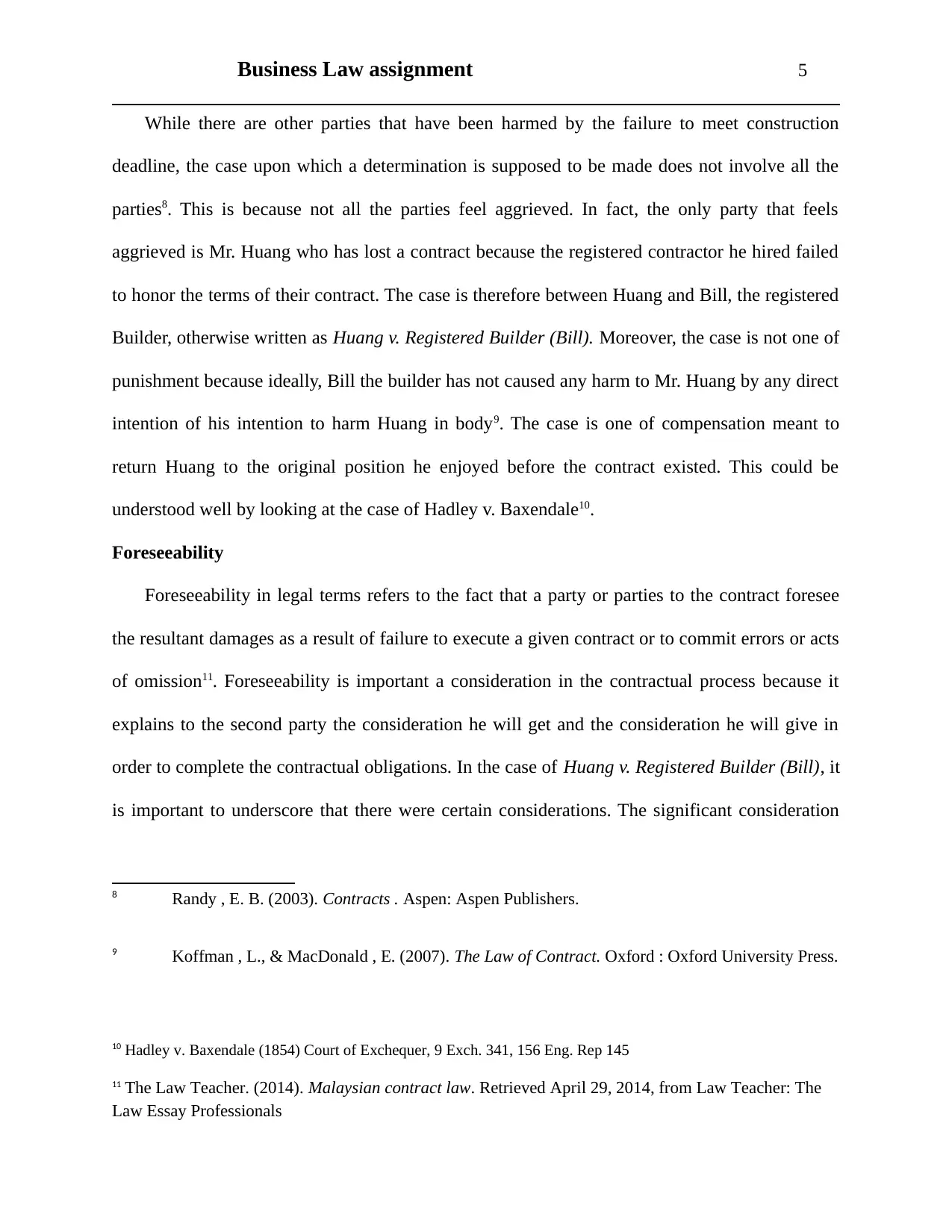
Business Law assignment 5
While there are other parties that have been harmed by the failure to meet construction
deadline, the case upon which a determination is supposed to be made does not involve all the
parties8. This is because not all the parties feel aggrieved. In fact, the only party that feels
aggrieved is Mr. Huang who has lost a contract because the registered contractor he hired failed
to honor the terms of their contract. The case is therefore between Huang and Bill, the registered
Builder, otherwise written as Huang v. Registered Builder (Bill). Moreover, the case is not one of
punishment because ideally, Bill the builder has not caused any harm to Mr. Huang by any direct
intention of his intention to harm Huang in body9. The case is one of compensation meant to
return Huang to the original position he enjoyed before the contract existed. This could be
understood well by looking at the case of Hadley v. Baxendale10.
Foreseeability
Foreseeability in legal terms refers to the fact that a party or parties to the contract foresee
the resultant damages as a result of failure to execute a given contract or to commit errors or acts
of omission11. Foreseeability is important a consideration in the contractual process because it
explains to the second party the consideration he will get and the consideration he will give in
order to complete the contractual obligations. In the case of Huang v. Registered Builder (Bill), it
is important to underscore that there were certain considerations. The significant consideration
8 Randy , E. B. (2003). Contracts . Aspen: Aspen Publishers.
9 Koffman , L., & MacDonald , E. (2007). The Law of Contract. Oxford : Oxford University Press.
10 Hadley v. Baxendale (1854) Court of Exchequer, 9 Exch. 341, 156 Eng. Rep 145
11 The Law Teacher. (2014). Malaysian contract law. Retrieved April 29, 2014, from Law Teacher: The
Law Essay Professionals
While there are other parties that have been harmed by the failure to meet construction
deadline, the case upon which a determination is supposed to be made does not involve all the
parties8. This is because not all the parties feel aggrieved. In fact, the only party that feels
aggrieved is Mr. Huang who has lost a contract because the registered contractor he hired failed
to honor the terms of their contract. The case is therefore between Huang and Bill, the registered
Builder, otherwise written as Huang v. Registered Builder (Bill). Moreover, the case is not one of
punishment because ideally, Bill the builder has not caused any harm to Mr. Huang by any direct
intention of his intention to harm Huang in body9. The case is one of compensation meant to
return Huang to the original position he enjoyed before the contract existed. This could be
understood well by looking at the case of Hadley v. Baxendale10.
Foreseeability
Foreseeability in legal terms refers to the fact that a party or parties to the contract foresee
the resultant damages as a result of failure to execute a given contract or to commit errors or acts
of omission11. Foreseeability is important a consideration in the contractual process because it
explains to the second party the consideration he will get and the consideration he will give in
order to complete the contractual obligations. In the case of Huang v. Registered Builder (Bill), it
is important to underscore that there were certain considerations. The significant consideration
8 Randy , E. B. (2003). Contracts . Aspen: Aspen Publishers.
9 Koffman , L., & MacDonald , E. (2007). The Law of Contract. Oxford : Oxford University Press.
10 Hadley v. Baxendale (1854) Court of Exchequer, 9 Exch. 341, 156 Eng. Rep 145
11 The Law Teacher. (2014). Malaysian contract law. Retrieved April 29, 2014, from Law Teacher: The
Law Essay Professionals
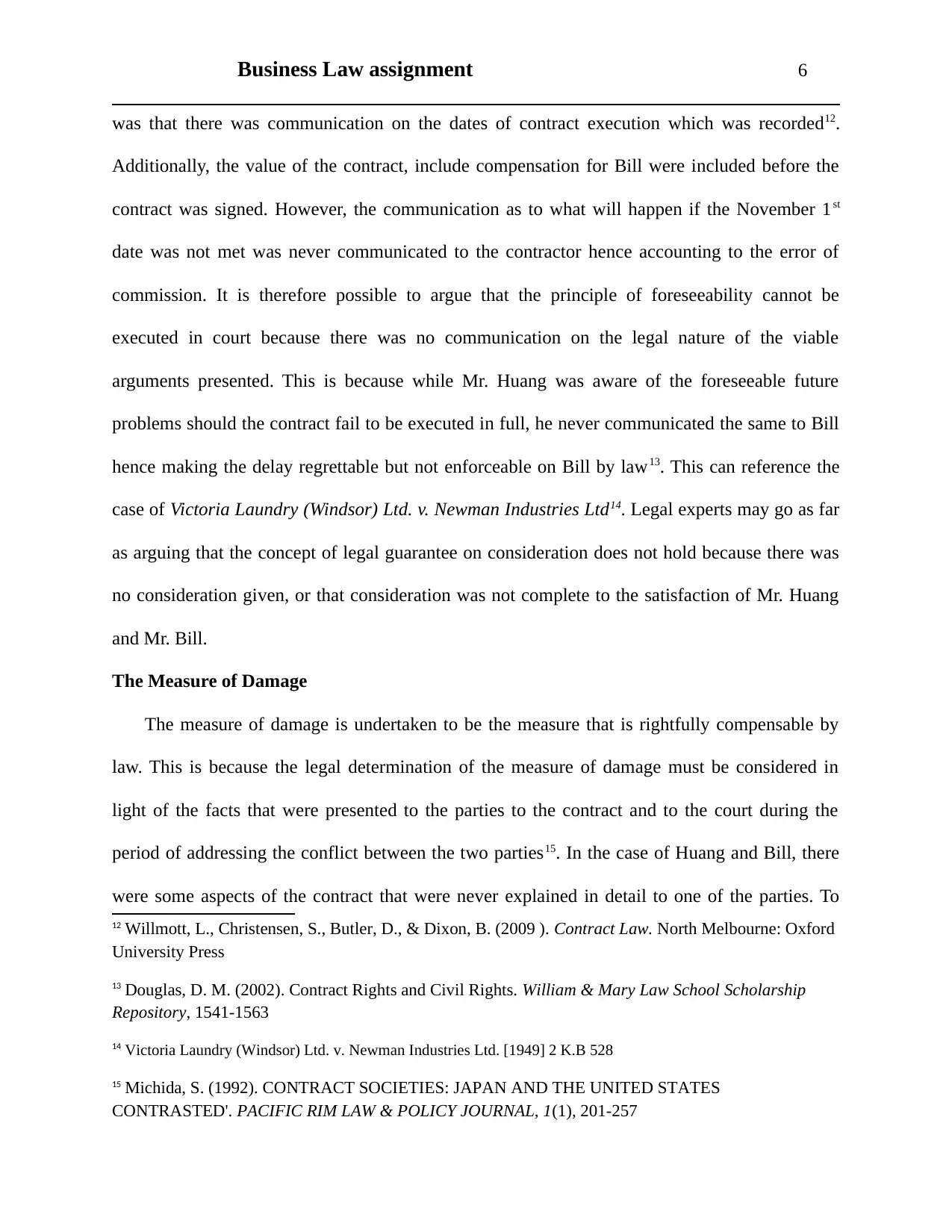
Business Law assignment 6
was that there was communication on the dates of contract execution which was recorded12.
Additionally, the value of the contract, include compensation for Bill were included before the
contract was signed. However, the communication as to what will happen if the November 1st
date was not met was never communicated to the contractor hence accounting to the error of
commission. It is therefore possible to argue that the principle of foreseeability cannot be
executed in court because there was no communication on the legal nature of the viable
arguments presented. This is because while Mr. Huang was aware of the foreseeable future
problems should the contract fail to be executed in full, he never communicated the same to Bill
hence making the delay regrettable but not enforceable on Bill by law13. This can reference the
case of Victoria Laundry (Windsor) Ltd. v. Newman Industries Ltd14. Legal experts may go as far
as arguing that the concept of legal guarantee on consideration does not hold because there was
no consideration given, or that consideration was not complete to the satisfaction of Mr. Huang
and Mr. Bill.
The Measure of Damage
The measure of damage is undertaken to be the measure that is rightfully compensable by
law. This is because the legal determination of the measure of damage must be considered in
light of the facts that were presented to the parties to the contract and to the court during the
period of addressing the conflict between the two parties15. In the case of Huang and Bill, there
were some aspects of the contract that were never explained in detail to one of the parties. To
12 Willmott, L., Christensen, S., Butler, D., & Dixon, B. (2009 ). Contract Law. North Melbourne: Oxford
University Press
13 Douglas, D. M. (2002). Contract Rights and Civil Rights. William & Mary Law School Scholarship
Repository, 1541-1563
14 Victoria Laundry (Windsor) Ltd. v. Newman Industries Ltd. [1949] 2 K.B 528
15 Michida, S. (1992). CONTRACT SOCIETIES: JAPAN AND THE UNITED STATES
CONTRASTED'. PACIFIC RIM LAW & POLICY JOURNAL, 1(1), 201-257
was that there was communication on the dates of contract execution which was recorded12.
Additionally, the value of the contract, include compensation for Bill were included before the
contract was signed. However, the communication as to what will happen if the November 1st
date was not met was never communicated to the contractor hence accounting to the error of
commission. It is therefore possible to argue that the principle of foreseeability cannot be
executed in court because there was no communication on the legal nature of the viable
arguments presented. This is because while Mr. Huang was aware of the foreseeable future
problems should the contract fail to be executed in full, he never communicated the same to Bill
hence making the delay regrettable but not enforceable on Bill by law13. This can reference the
case of Victoria Laundry (Windsor) Ltd. v. Newman Industries Ltd14. Legal experts may go as far
as arguing that the concept of legal guarantee on consideration does not hold because there was
no consideration given, or that consideration was not complete to the satisfaction of Mr. Huang
and Mr. Bill.
The Measure of Damage
The measure of damage is undertaken to be the measure that is rightfully compensable by
law. This is because the legal determination of the measure of damage must be considered in
light of the facts that were presented to the parties to the contract and to the court during the
period of addressing the conflict between the two parties15. In the case of Huang and Bill, there
were some aspects of the contract that were never explained in detail to one of the parties. To
12 Willmott, L., Christensen, S., Butler, D., & Dixon, B. (2009 ). Contract Law. North Melbourne: Oxford
University Press
13 Douglas, D. M. (2002). Contract Rights and Civil Rights. William & Mary Law School Scholarship
Repository, 1541-1563
14 Victoria Laundry (Windsor) Ltd. v. Newman Industries Ltd. [1949] 2 K.B 528
15 Michida, S. (1992). CONTRACT SOCIETIES: JAPAN AND THE UNITED STATES
CONTRASTED'. PACIFIC RIM LAW & POLICY JOURNAL, 1(1), 201-257
⊘ This is a preview!⊘
Do you want full access?
Subscribe today to unlock all pages.

Trusted by 1+ million students worldwide
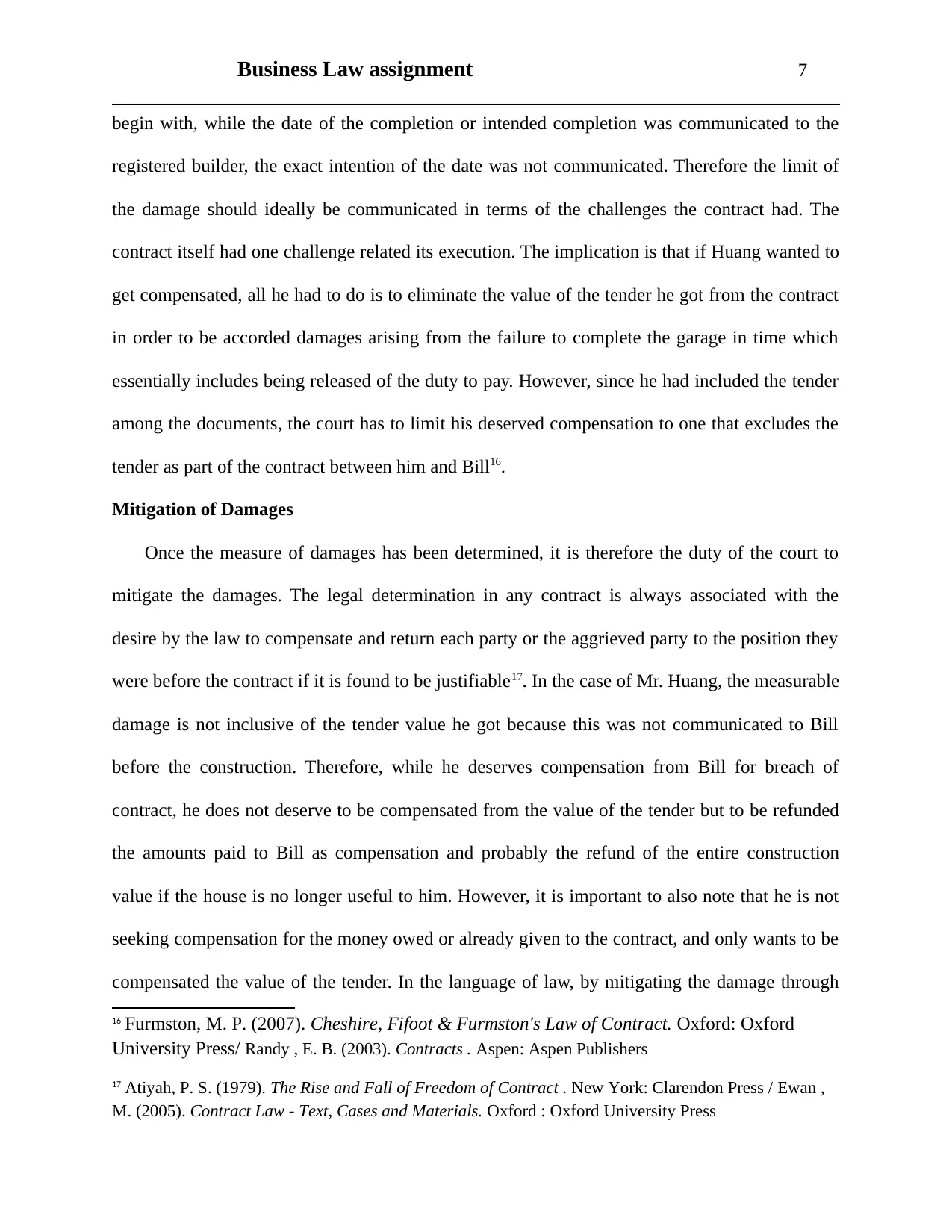
Business Law assignment 7
begin with, while the date of the completion or intended completion was communicated to the
registered builder, the exact intention of the date was not communicated. Therefore the limit of
the damage should ideally be communicated in terms of the challenges the contract had. The
contract itself had one challenge related its execution. The implication is that if Huang wanted to
get compensated, all he had to do is to eliminate the value of the tender he got from the contract
in order to be accorded damages arising from the failure to complete the garage in time which
essentially includes being released of the duty to pay. However, since he had included the tender
among the documents, the court has to limit his deserved compensation to one that excludes the
tender as part of the contract between him and Bill16.
Mitigation of Damages
Once the measure of damages has been determined, it is therefore the duty of the court to
mitigate the damages. The legal determination in any contract is always associated with the
desire by the law to compensate and return each party or the aggrieved party to the position they
were before the contract if it is found to be justifiable17. In the case of Mr. Huang, the measurable
damage is not inclusive of the tender value he got because this was not communicated to Bill
before the construction. Therefore, while he deserves compensation from Bill for breach of
contract, he does not deserve to be compensated from the value of the tender but to be refunded
the amounts paid to Bill as compensation and probably the refund of the entire construction
value if the house is no longer useful to him. However, it is important to also note that he is not
seeking compensation for the money owed or already given to the contract, and only wants to be
compensated the value of the tender. In the language of law, by mitigating the damage through
16 Furmston, M. P. (2007). Cheshire, Fifoot & Furmston's Law of Contract. Oxford: Oxford
University Press/ Randy , E. B. (2003). Contracts . Aspen: Aspen Publishers
17 Atiyah, P. S. (1979). The Rise and Fall of Freedom of Contract . New York: Clarendon Press / Ewan ,
M. (2005). Contract Law - Text, Cases and Materials. Oxford : Oxford University Press
begin with, while the date of the completion or intended completion was communicated to the
registered builder, the exact intention of the date was not communicated. Therefore the limit of
the damage should ideally be communicated in terms of the challenges the contract had. The
contract itself had one challenge related its execution. The implication is that if Huang wanted to
get compensated, all he had to do is to eliminate the value of the tender he got from the contract
in order to be accorded damages arising from the failure to complete the garage in time which
essentially includes being released of the duty to pay. However, since he had included the tender
among the documents, the court has to limit his deserved compensation to one that excludes the
tender as part of the contract between him and Bill16.
Mitigation of Damages
Once the measure of damages has been determined, it is therefore the duty of the court to
mitigate the damages. The legal determination in any contract is always associated with the
desire by the law to compensate and return each party or the aggrieved party to the position they
were before the contract if it is found to be justifiable17. In the case of Mr. Huang, the measurable
damage is not inclusive of the tender value he got because this was not communicated to Bill
before the construction. Therefore, while he deserves compensation from Bill for breach of
contract, he does not deserve to be compensated from the value of the tender but to be refunded
the amounts paid to Bill as compensation and probably the refund of the entire construction
value if the house is no longer useful to him. However, it is important to also note that he is not
seeking compensation for the money owed or already given to the contract, and only wants to be
compensated the value of the tender. In the language of law, by mitigating the damage through
16 Furmston, M. P. (2007). Cheshire, Fifoot & Furmston's Law of Contract. Oxford: Oxford
University Press/ Randy , E. B. (2003). Contracts . Aspen: Aspen Publishers
17 Atiyah, P. S. (1979). The Rise and Fall of Freedom of Contract . New York: Clarendon Press / Ewan ,
M. (2005). Contract Law - Text, Cases and Materials. Oxford : Oxford University Press
Paraphrase This Document
Need a fresh take? Get an instant paraphrase of this document with our AI Paraphraser
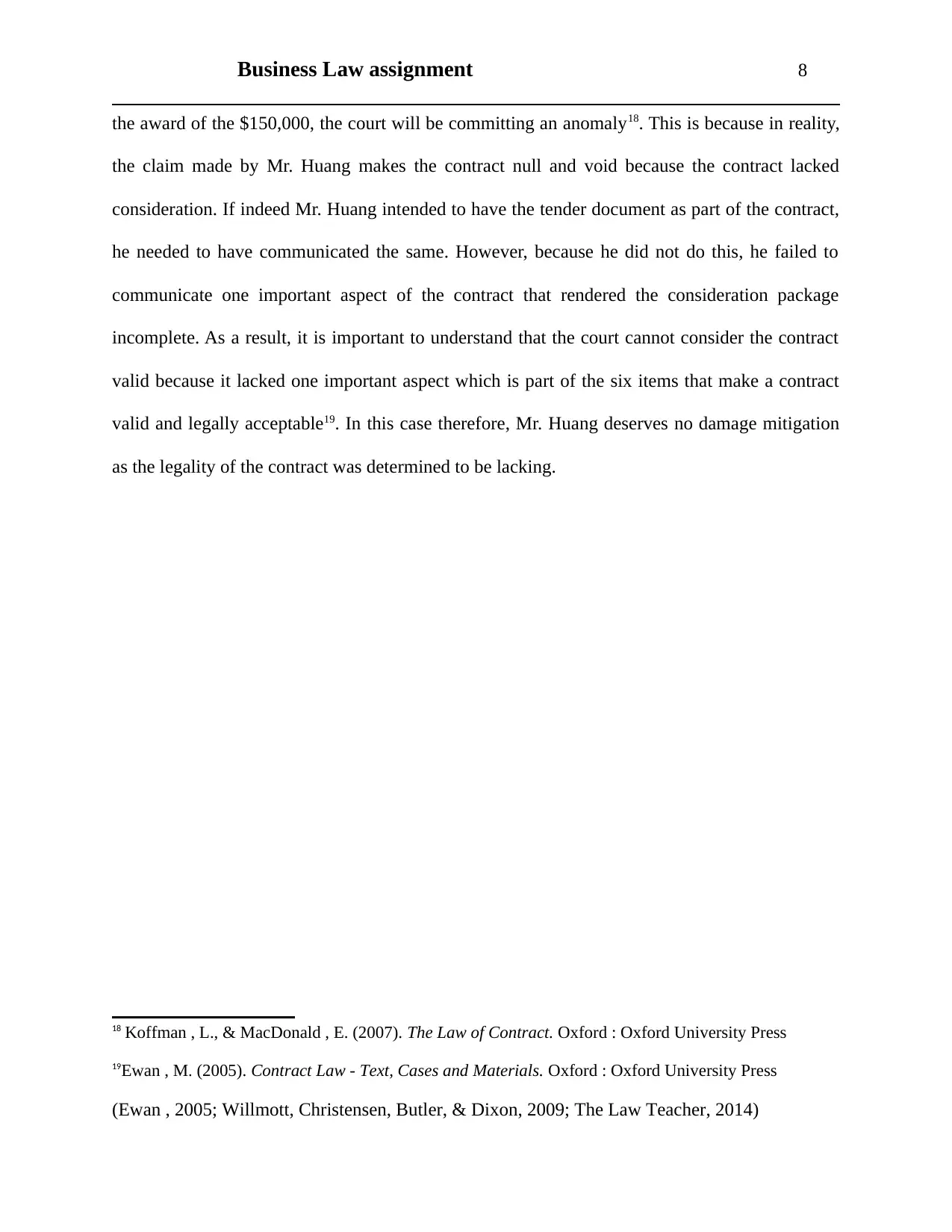
Business Law assignment 8
the award of the $150,000, the court will be committing an anomaly18. This is because in reality,
the claim made by Mr. Huang makes the contract null and void because the contract lacked
consideration. If indeed Mr. Huang intended to have the tender document as part of the contract,
he needed to have communicated the same. However, because he did not do this, he failed to
communicate one important aspect of the contract that rendered the consideration package
incomplete. As a result, it is important to understand that the court cannot consider the contract
valid because it lacked one important aspect which is part of the six items that make a contract
valid and legally acceptable19. In this case therefore, Mr. Huang deserves no damage mitigation
as the legality of the contract was determined to be lacking.
18 Koffman , L., & MacDonald , E. (2007). The Law of Contract. Oxford : Oxford University Press
19Ewan , M. (2005). Contract Law - Text, Cases and Materials. Oxford : Oxford University Press
(Ewan , 2005; Willmott, Christensen, Butler, & Dixon, 2009; The Law Teacher, 2014)
the award of the $150,000, the court will be committing an anomaly18. This is because in reality,
the claim made by Mr. Huang makes the contract null and void because the contract lacked
consideration. If indeed Mr. Huang intended to have the tender document as part of the contract,
he needed to have communicated the same. However, because he did not do this, he failed to
communicate one important aspect of the contract that rendered the consideration package
incomplete. As a result, it is important to understand that the court cannot consider the contract
valid because it lacked one important aspect which is part of the six items that make a contract
valid and legally acceptable19. In this case therefore, Mr. Huang deserves no damage mitigation
as the legality of the contract was determined to be lacking.
18 Koffman , L., & MacDonald , E. (2007). The Law of Contract. Oxford : Oxford University Press
19Ewan , M. (2005). Contract Law - Text, Cases and Materials. Oxford : Oxford University Press
(Ewan , 2005; Willmott, Christensen, Butler, & Dixon, 2009; The Law Teacher, 2014)
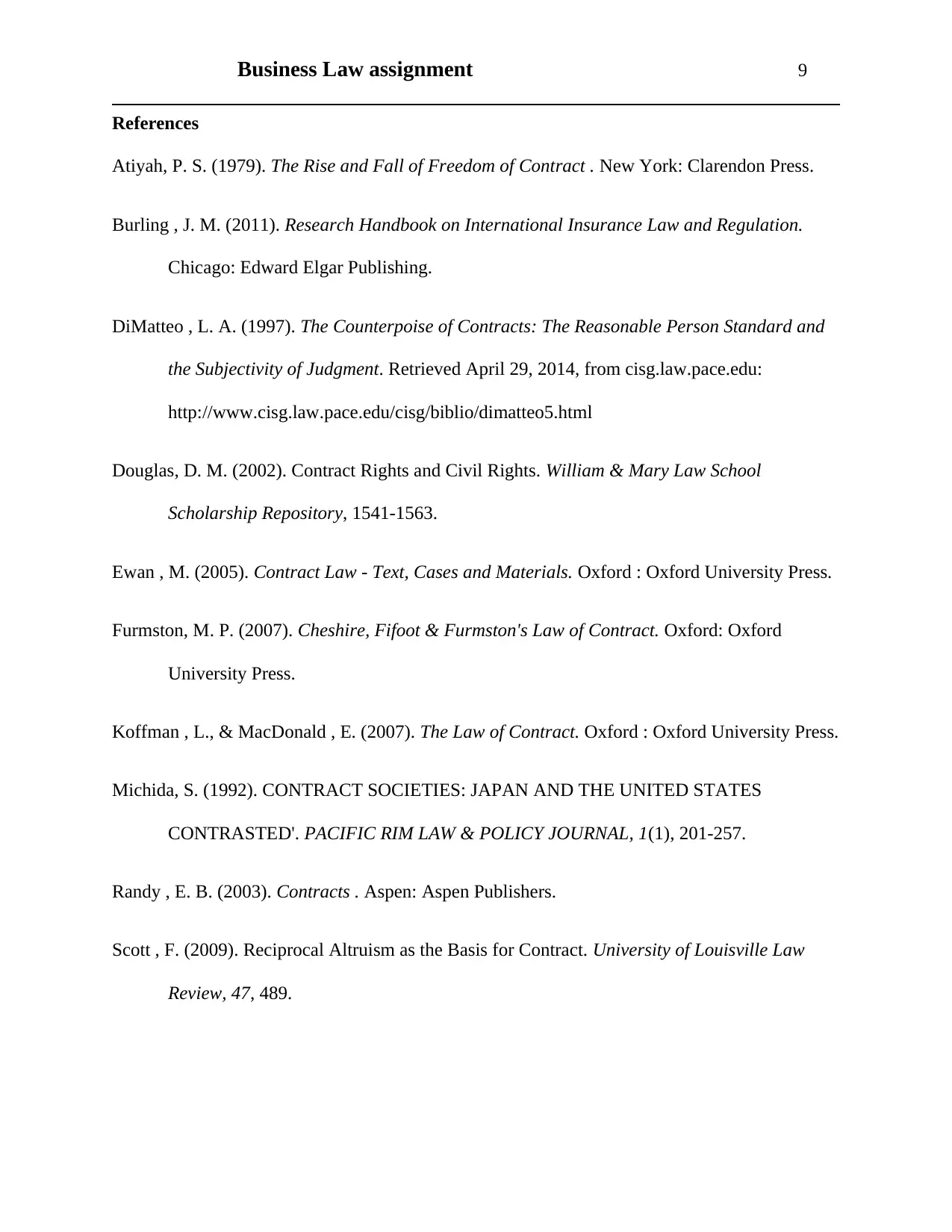
Business Law assignment 9
References
Atiyah, P. S. (1979). The Rise and Fall of Freedom of Contract . New York: Clarendon Press.
Burling , J. M. (2011). Research Handbook on International Insurance Law and Regulation.
Chicago: Edward Elgar Publishing.
DiMatteo , L. A. (1997). The Counterpoise of Contracts: The Reasonable Person Standard and
the Subjectivity of Judgment. Retrieved April 29, 2014, from cisg.law.pace.edu:
http://www.cisg.law.pace.edu/cisg/biblio/dimatteo5.html
Douglas, D. M. (2002). Contract Rights and Civil Rights. William & Mary Law School
Scholarship Repository, 1541-1563.
Ewan , M. (2005). Contract Law - Text, Cases and Materials. Oxford : Oxford University Press.
Furmston, M. P. (2007). Cheshire, Fifoot & Furmston's Law of Contract. Oxford: Oxford
University Press.
Koffman , L., & MacDonald , E. (2007). The Law of Contract. Oxford : Oxford University Press.
Michida, S. (1992). CONTRACT SOCIETIES: JAPAN AND THE UNITED STATES
CONTRASTED'. PACIFIC RIM LAW & POLICY JOURNAL, 1(1), 201-257.
Randy , E. B. (2003). Contracts . Aspen: Aspen Publishers.
Scott , F. (2009). Reciprocal Altruism as the Basis for Contract. University of Louisville Law
Review, 47, 489.
References
Atiyah, P. S. (1979). The Rise and Fall of Freedom of Contract . New York: Clarendon Press.
Burling , J. M. (2011). Research Handbook on International Insurance Law and Regulation.
Chicago: Edward Elgar Publishing.
DiMatteo , L. A. (1997). The Counterpoise of Contracts: The Reasonable Person Standard and
the Subjectivity of Judgment. Retrieved April 29, 2014, from cisg.law.pace.edu:
http://www.cisg.law.pace.edu/cisg/biblio/dimatteo5.html
Douglas, D. M. (2002). Contract Rights and Civil Rights. William & Mary Law School
Scholarship Repository, 1541-1563.
Ewan , M. (2005). Contract Law - Text, Cases and Materials. Oxford : Oxford University Press.
Furmston, M. P. (2007). Cheshire, Fifoot & Furmston's Law of Contract. Oxford: Oxford
University Press.
Koffman , L., & MacDonald , E. (2007). The Law of Contract. Oxford : Oxford University Press.
Michida, S. (1992). CONTRACT SOCIETIES: JAPAN AND THE UNITED STATES
CONTRASTED'. PACIFIC RIM LAW & POLICY JOURNAL, 1(1), 201-257.
Randy , E. B. (2003). Contracts . Aspen: Aspen Publishers.
Scott , F. (2009). Reciprocal Altruism as the Basis for Contract. University of Louisville Law
Review, 47, 489.
⊘ This is a preview!⊘
Do you want full access?
Subscribe today to unlock all pages.

Trusted by 1+ million students worldwide
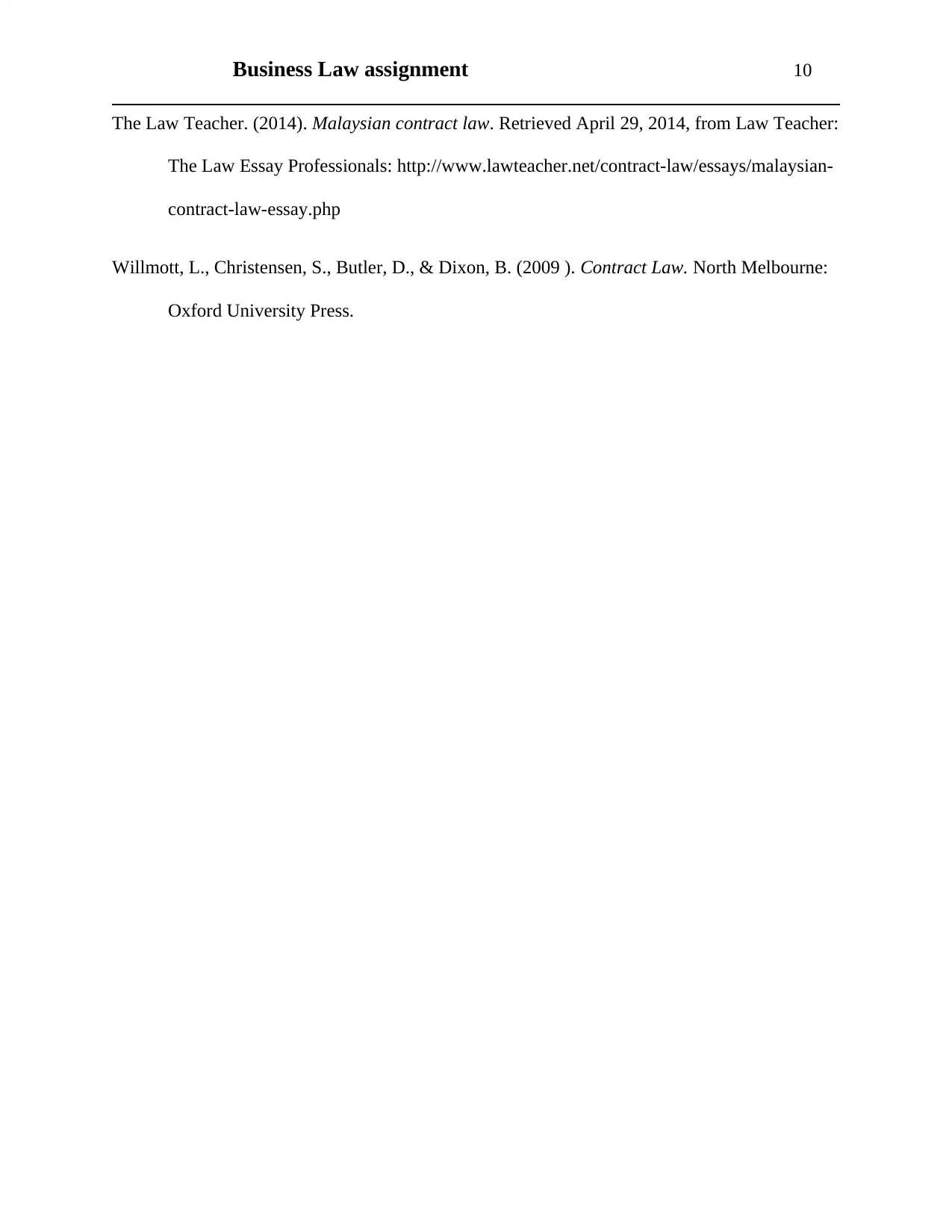
Business Law assignment 10
The Law Teacher. (2014). Malaysian contract law. Retrieved April 29, 2014, from Law Teacher:
The Law Essay Professionals: http://www.lawteacher.net/contract-law/essays/malaysian-
contract-law-essay.php
Willmott, L., Christensen, S., Butler, D., & Dixon, B. (2009 ). Contract Law. North Melbourne:
Oxford University Press.
The Law Teacher. (2014). Malaysian contract law. Retrieved April 29, 2014, from Law Teacher:
The Law Essay Professionals: http://www.lawteacher.net/contract-law/essays/malaysian-
contract-law-essay.php
Willmott, L., Christensen, S., Butler, D., & Dixon, B. (2009 ). Contract Law. North Melbourne:
Oxford University Press.
1 out of 10
Related Documents
Your All-in-One AI-Powered Toolkit for Academic Success.
+13062052269
info@desklib.com
Available 24*7 on WhatsApp / Email
![[object Object]](/_next/static/media/star-bottom.7253800d.svg)
Unlock your academic potential
Copyright © 2020–2025 A2Z Services. All Rights Reserved. Developed and managed by ZUCOL.




